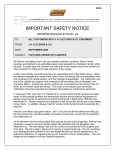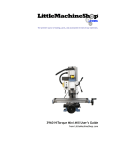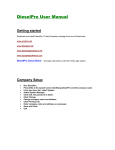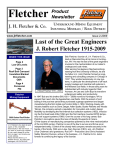Download 100 - JH Fletcher & Co.
Transcript
J. H. FLETCHER & CO. Box 2187 – Huntington, WV 25722-2187 – 304/525-7811 – FAX 304/525-4025 IMPORTANT SAFETY NOTICE INFORMATION BULLETIN NO. 100 TO: ALL OWNERS, OPERATORS AND REBUILDERS OF ROOF BOLTING EQUIPMENT FROM: RISK MANAGEMENT DEPARTMENT J.H. FLETCHER & CO. DATE: MARCH 2007 SUBJECT: POTENTIAL HAZARDS INVOLVING MINING (TRAILING) CABLE PREAMBLE: All J.H. Fletcher & Co. (“Fletcher”) electrical face equipment utilizes a trailing cable. The trailing cable (“cable”) is connected to the mine’s electrical power grid and delivers electrical power to the machine. The cable conducts high current electricity. It also is a large, heavy object. Therefore, it is imperative that ALL mining personnel maintain safe practices while working with and around a cable and the cable system. This Safety Notice is a reminder of certain hazards and an overview of some of the components Fletcher incorporates into its machines in order to promote safety and reduce the likelihood of cable-related injuries. Most Fletcher roof bolting machines are equipped with a cable reel system. This system allows the cable to be released automatically as the machine is trammed forward and to be mechanically taken-up by activation of the cable reel. A small quantity of roof bolting machines are equipped with trailing cable wrapping posts, in which the cable is stored at the rear of the machine. This system requires manual release and retrieval. Operators and mine personnel are not at risk for a cable-related injury if the user instructions published by Fletcher and safe working and maintenance practices are followed. Any person, including machine operators and any one that is working in the vicinity of a cable, can be injured by a trailing cable if they do not pay attention to the cable, if the system is misused or if there is a failure to maintain the cable system. PURPOSE: This Information Bulletin is published to remind operators and users of potential hazards that may arise from misuse and/or failure to maintain the cable system. SEE REVERSE SIDE Fletcher Information Bulletin 100 February 2007 Page Two GENERAL OVERVIEW: If a Fletcher roof bolting machine is in use at your mine, it should be inspected regularly, meaning no less than once per 8 hour shift. You should make sure that the cable reel system functions are operating properly and check for damage to the cable or to the cable reel and the entire electrical system. All mine personnel should be frequently reminded and instructed of safety measures when working with and around trailing cable and the trailing cable system. Training is essential. Each operator, helper and person assigned to work with and/or around the vicinity in which a roof bolting machine is being used should be trained in safe cable procedures. All should be warned of the hazards of serious injury and even death if there is a failure to follow safe procedures, such as ignoring maintenance problems and failing to protect the trailing cable itself. All mine personnel must maintain a proper look out and know where the trailing cable is at all times. The roof bolting machine should be taken out of service and not used until corrective action is taken if any of the following occurs: (1) the cable can potentially pull or whip into the tram deck if there is no guard to prevent it from doing so; (2) the cable whips or springs while being spooled, possibly due to the flow setting being too high; (3) the cable comes under tension and gets stretched or pulled, such as if the pressure setting is too high; (4) the cable’s protective outer covering (casing) is damaged, cut or cracked, posing a risk for electrical current discharge, such as electrical shock or spark generation; (5) the cable reel control valve mechanism is not functioning properly; (6) electrical surges occur during machine operation, such as the machine power “flickers” or fades in and out; (7) personnel do not know where the cable is or are required to work over or around the cable such that any cable movement could cause a person to loose his balance or to be struck by the cable. (8) the trailing cable is run over by another machine, causing damage to the cable (9) the trailing cable is run over by the machine and the machine becomes hung up Failure to follow any of these safety recommendations could result in serious injury or death. The safety recommendations listed above, and those discussed in more detail in the following, are the responsibility of every mine owner and individual who comes in contact with a Fletcher roof bolting machine. Fletcher Information Bulletin 100 February 2007 Page Three SPECIFIC HAZARD CHECKS: TRAM DECK Tram Enable Pedal Machines built or remanufactured after 1997 are equipped with a tram enable pedal in the tram deck (see Attachment A from Information Bulletin #77). The purpose of the tram enable pedal is to remind operators of the necessity of maintaining all body parts inside the tram deck while operating any tram control. The machine should not be capable of being trammed without the operator fully seated inside the tram deck and his foot on the tram enable pedal,. Tram Deck Canopy Addition After 1995 all new and remanufactured machines have had the tram deck canopy support located on the outside corner of the tram deck (see Attachment B). This creates a barrier to prevent the trailing cable from pulling into the tram deck area. Operators should be reminded to never attempt to pull the trailing cable into the tram deck area. Any action, such as pulling the cable into the tram deck, can cause damage to the cable, resulting in an electrical shock or spark hazard. Also, this type of conduct creates hazards that could cause serious injury or death such as a person being struck by the cable as it spools or creation of tension within the cable, causing it to fling or whip. If your machine does not have a tram deck canopy addition, it is recommended that you contact your local Fletcher representative for assistance in changing your machine. Cable Reel Control A detented handle is located in the tram deck. When activated (pushed up), the cable is taken up (spooled). In order to release the cable the control must be in the neutral position and the operator must be seated with his foot depressing the tram enable pedal while moving the tram control or controls to the forward position. The trailing cable is also released when using position controls to move the machine forward while the cable reel handle is in the off position. Prior to 1998, the cable reel control mechanism was different. In the Product Newsletter, Q1 1998 (see Attachment C), Fletcher notified customers that we had reversed the hydraulic flow in this circuit so that the operator must push up on the handle to spool the cable up and return it to neutral to release cable as the machine moves forward. Inspect your machine to confirm that the cable reel control is properly functioning as described above. If it is not or if you have not implemented the 1998 change, we strongly recommend that you order the change kit today (part no. 300282). Fletcher can assist your mine mechanic in making this necessary change. Operators and maintenance personnel should be reminded that the spool handle must be pushed up in order to spool the cable. Failure to maintain the system in this fashion could cause serious injury or death by unexpected spooling of cable. SEE REVERSE SIDE Fletcher Information Bulletin 100 February 2007 Page Four Most mine operators and machine operators adopt a means of signaling personnel as to when the cable is being spooled. There are many different signaling methods such as verbal announcements. Each mine and operator should have a consistent signaling process and ensure that all individuals that work in the area of the cable know and understand what the signal is for cable activity and what the signal means. Failure to consistently adopt and use a signaling system could result in serious injury or death because a person was standing too close to, or in the vicinity of, a moving cable. Cable Reel Package Valve The package valve on the machine controls the speed of the cable and amount of tension when it is spooled up or is released from the cable reel (see Attachment D). The package valve must only be adjusted by qualified maintenance personnel at the mine. Adjustments of the valve by unqualified personnel could result in the cable being spooled up too fast or in the pressure being set too high or too low to take up the cable properly. Both situations could result in serious injuries (such as back strain or head injury) or death, due to contact with a whipping cable. To properly adjust this valve, the maintenance personnel should thoroughly read the Service Manual that provides information on the cable reel package valve. CABLE REEL The cable on the roof drill must be protected at all times, to ensure power is safely transferred to the roof drill. The cable is an electrical cord. In comparison to a common household cord that conducts 110 volts, this cable can provide between 440 and 950 volts of electrical power. All mine personnel must have a respect for this vital piece of equipment and work to protect it. In addition to ongoing safe work practices, to minimize the possibility of entanglement, overstretching of the cable, damage to the cable casing, and/or separation of the cable from the roof drill, the following machine parts may be used: Cable Retainer Roof drills without a cable reel are required by MSHA to have a cable strain clamp holder at the rear of the bolter. This clamp ensures that the cable does not separate from the control box (see Attachment E). It is essential that this clamp be properly maintained, at all times, to preserve the integrity of the cable. Trailing Cable Holder On a small number of roof drills, a water box or duster is located on the rear of the bolter’s bumper. However, it is possible that the cable could become entangled around the box. In order to prevent this occurrence, a trailing cable holder has been manufactured (see Attachment F). The holder ensures the cable is contained at the rear-most area of the roof bolter. If your machine is equipped with a water box or duster and the holder is not in place, contact Fletcher immediately in order to have the machine repaired. Failure to properly maintain the trailing cable holder could result in serious injury or death from whipping, entangled or damaged cable. Fletcher Information Bulletin 100 February 2007 Page Five Cable Eye and Hooks Fletcher offers cable eye hooks (See Attachment G) that can be placed on the rear corners of the roof drill to help prevent the operator from running over cable while reverse tramming. They also provide a smooth edge for the cable to wrap around. These devices reduce instances of cable fraying due to pressure injury to the cable and its wires. As above, any damage to the cable itself creates a hazard that could result in serious injury or death. Fletcher recommends you purchase these devices from us and review their placement on your machine with a Fletcher representative. Training There is no substitute for training. Fletcher believes that cable hazards and cable reel operation should be the subject of regular safety talks at your mine. Enclosed is a cable safety flyer (5 copies) that can be presented to your operators, along with two posters that can be displayed in prominent locations to reinforce the dangers of whipping cable. Fletcher strongly recommends that you plan to review this material with all users of Fletcher equipment as soon as possible. CLOSING If you no longer own or operate a machine that might be affected by this notification please provide new ownership or machine location information by notifying David Cooper at [email protected]. These reminders are provided to promote ongoing mine safety. Fletcher recommends that you thoroughly review this bulletin, make the changes where it may be applicable, and train your operators to reduce the risk of injury to operators who handle cable. Contact Fletcher’s Service Department for assistance with ordering the parts needed. If you have any questions concerning this bulletin, or if you need additional training material, please call the Risk Management Department at (304) 525-7811. IB 100 ATTACHMENT B POST AT REAR OF ROOF BOLTER Canopy Support on Outside Corner IB 100 ATTACHMENT C ARTICLE ON CHANGING DIRECTION OF CABLE REEL VALVE FROM FLETCHER PRODUCT NEWSLETTER Q1 1998 IB 100 ATTACHMENT D CABLE REEL PACKAGE VALVE This is an example of one type of cable reel package valve. Information regarding the specific cable reel package valve on your machine(s) can be found in the Parts Book for that machine. NOTE: Only to be adjusted by a qualified maintenance person. See Service Manual for additional information on the Cable Reel Package Valve. IB 100 ATTACHMENT E CABLE STRAIN CLAMP Cable Strain Clamp Attached to Machine Without a Cable Reel IB 100 ATTACHMENT F TRAILING CABLE HOLDER EXTENSION Water Box NOTE: Only for machines that have a water box protruding from the rear of chassis. Contact J.H. Fletcher & Co. for specific information for your type of machine. IB 100 ATTACHMENT G CABLE EYE NOTE: Contact J. H. Fletcher & Co. about placement of any cable eye hook on your machine. SAFETY PRESENTATION WARNING CRUSHING HAZARD NEVER STAND ON OR STRADDLE A TRAILING CABLE THAT IS BEING REELED IN FAILURE TO OBEY THESE INSTRUCTIONS COULD RESULT IN SERIOUS INJURY OR DEATH J.H. Fletcher & Co. Part No. 139134























